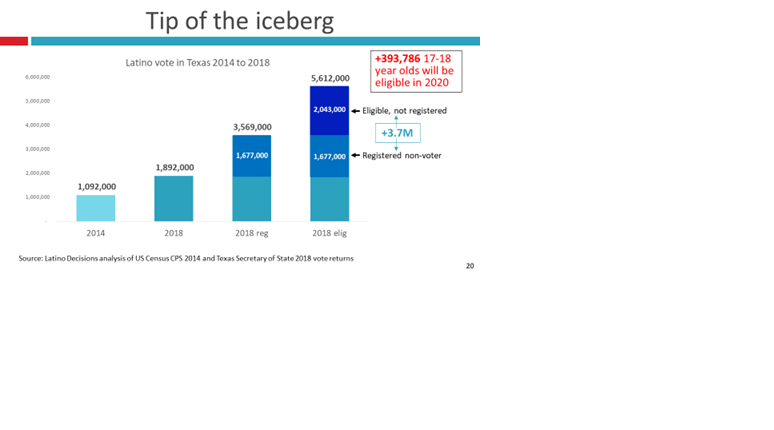Last Monday the Los Angeles Times reported Latino voters favor Democrat Jerry Brown over Republican Meg Whitman by a wide margin. Despite a preference for Brown, data from Latino Decisions suggest that many Latinos, in particular newly naturalized immigrant voters were undecided in the gubernatorial election. Then came the allegations that Meg Whitman had mistreated her undocumented immigrant Latina housekeeper and questions about how Latinos would evaluate Whitman. The group most likely to have a negative reaction to the housekeeper dust-up is newly naturalized Latino voters, and among this cohort, which comprises 23% of all Latino registered voters, 37% preferred Brown, 32% Whitman, and 31% were undecided in the September 25 data.

Newly naturalized voters (defined as those who have been U.S. citizens 10 years or less) have less familiarity and memory of the Brown days, and less attachment to the former Governor. For both Brown and Whitman, this segment of the electorate reports the highest “don’t knows” when asked to rate them favorably or unfavorably, and thus is the best target for influence over the final four weeks. For example, when looking to the data among newly naturalized Latinos, 30% are favorable towards Brown, 13% unfavorable and 57% state they haven’t heard enough to say. For Whitman 21% are favorable, 20% are unfavorable, and 59% state they haven’t heard enough say.
In contrast, longer time naturalized citizens, and U.S. born Latinos were more likely to already side with Brown, and be more informed about both candidates. It’s not to say that more recent citizens are not Democratic voters, they are. Marcelo Gaete, who first discovered this trend in the data, and I also looked at the U.S. Senate contest and found newly naturalized Latino voters overwhelmingly prefer Barbara Boxer by a margin of 79% to 7% for Fiorina (with 14% undecided). Thus, it is just in the Governor’s race that these immigrant voters are less informed, and more undecided. (Full results broken out by years naturalized, posted here)

We should remind readers that this is not a trivial part of the California electorate. Marcelo Gaete pointed me to the Political Data Inc. website, which runs counts on the official Statewide database of CA voters, by race and ethnicity. Overall, there are 3.41 million Latino registered voters in California (approximately 20% of all registered voters statewide), and according to the demographic information in the Latino Decisions survey with LAT/USC, 44% of all Latino registered voters in California are foreign-born naturalized citizens, or about 1.5 million registered voters. Among this group, there is a split, with 53% of foreign born stating they have been U.S. citizens for 10 years or less, and 47% stating they have been citizens for 11 years or longer. That leaves about 795,000 Latino registered voters in California who are newly naturalized (and about 705,000 who are longer-term naturalized citizens). In what many are forecasting to be a very close election, the housekeeper scandal could create a new negative impression of Whitman among this group of new citizens, who themselves, were not yet U.S. citizens 10 years ago. Yet negative news about Whitman alone does not necessarily inform voters about Brown, who still faces an information deficit among new naturalized voters (recall 57% said they had not heard enough to form an opinion)
IRCA Voters in California
In 1986, Congress passed the Immigration Reform and Control Act, which granted residency to nearly 2.7 million undocumented residents, the majority of whom were from Latin America. (Read 1986 statement by President Reagan) Nationally, 88.3% of IRCA eligible applicants were Latino, or roughly 2.4 million. Among those, 53.5% resided in California, or about 1.3 million Latino immigrants who were previously undocumented immigrants, eligible to start becoming citizens in the mid-1990s. (In a published academic paper, I discuss these numbers and trends, see here). There were two groups of immigrants eligible for legal permanent status under IRCA provisions. The first group included unauthorized immigrants who had been residing in the United States since before January 1, 1982 (Pre-1982s) and the second group included immigrants employed in seasonal agricultural work (SAWs) for a minimum of 90 days in the year prior to May 1986. Starting in 1992, the first wave of those who obtained legal resident status through the provisions of IRCA became eligible to apply for citizenship. Some observers have not only credited this new pool of eligible citizens for the surge in naturalizations in the mid-1990s but also for the significant growth in the Latino vote during this period.
Thus, it is not only that some Latino voters may have friends or family members who face immigration status issues, but for as many as 1.3 million Latino U.S. citizens in California, they themselves used to be undocumented immigrants, who had their status adjusted per IRCA. While Jerry Brown and Meg Whitman continue to debate the immigration issue more broadly, and the housekeeper scandal more specifically, many Latino voters will be paying very close attention, learning more about these two candidates who are far less known to Latino immigrant voters, and ultimately deciding how to vote for Governor over the next four weeks.
- Latino Decisions LAT/USC survey results by years naturalized
- Barreto, Ramirez & Woods research article on IRCA in California


